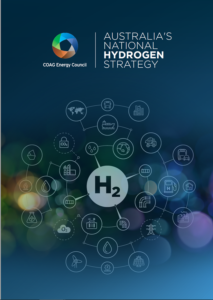Australia Issues National Hydrogen Strategy
By Stephen H. Crolius on December 05, 2019

Last month the Council of Australian Governments (COAG) Energy Council – “a Ministerial forum for the Commonwealth [of Australia], states and territories and New Zealand, to work together in the pursuit of national energy reforms” – issued a 137-page report entitled Australia’s National Hydrogen Strategy. For those focused on how ammonia energy will go from promising idea to practical reality, this is what the next step — the one after the discovery of ammonia’s virtues as a hydrogen carrier – could look like. The Strategy is detailed, comprehensive, and concerned with both practical measures in the near term and the arc of progress over the long term. And embedded within it are three ideas that are likely to have on-going relevance for ammonia energy implementation.
The first is the idea that ammonia energy implementation could proceed as an integral part of a broad, multi-stranded hydrogen economy roll-out. The typical case that contrasts with this is implementation of a discrete ammonia energy project in a way that is not obviously situated within an organized societal movement. Among the Strategy’s many illustrations of the integration idea is its treatment of The Hydrogen Utility (H2U). In Ammonia Energy’s many reports on H2U, it has always been clear that the enterprise enjoys the support of the South Australian government. But the implied context has been that of an entrepreneurial venture trying to forge a path for itself into a vaguely defined future. This view changes considerably in a Strategy case study entitled “Coordinated Regulatory Approach for Hydrogen Projects.” The case study identifies H2U’s “renewable hydrogen and green ammonia supply chain demonstrator” as one of three “megawatt-scale projects” that the state’s Hydrogen Regulatory Working Group is supporting, and in which “the South Australian Government has co-invested … over $40 million in grants and loans.” The other two projects are the Hydrogen Park South Australia (led by Australian Gas Networks) and the Hydrogen Superhub (led by French renewable energy company Neoen).
The second idea is that, in the words of the report, “ammonia production could be a key driver in creating a clean hydrogen industry.” In other words, while Australia sees ammonia energy implementation occurring within the broader hydrogen movement, it also sees hydrogen implementation depending in part on actions by the ammonia industry. A case study in the Strategy entitled “The ammonia advantage,” observes that “the single biggest current use for hydrogen globally and in Australia is for making the chemical ammonia.” This fact is found to be especially relevant for one the Strategy’s core expedients for launching the hydrogen sector: “hydrogen hubs.”
Hubs aggregate various users of hydrogen into one area. Doing so minimises the cost of providing infrastructure – such as powerlines, pipelines, storage tanks, refuelling stations, ports, roads or railway lines – and supports economies of scale in producing and delivering hydrogen to end users. Hubs also help focus efforts for innovation and building a ‘hydrogen-ready’ workforce.
Australia’s National Hydrogen Strategy, Commonwealth of Australia, November 2019
The report goes on, “Hydrogen hubs could be situated to take advantage of existing users or potential hydrogen markets. Supplying hydrogen to ammonia makers and oil refineries, for example, are clear early opportunities.” This concept merits consideration in other ammonia-producing jurisdictions that are interested in hydrogen.
The third idea is the questionable but entrenched notion that ammonia’s hazard profile is so extreme that, unlike hydrogen, its use must be circumscribed. The report’s formulation of this idea — “Because of its toxicity, it is likely using ammonia for fuel will be limited to large-scale industrial activities” — echoes a formulation found in the International Energy Agency’s The Future of Hydrogen. That report was released in June 2019 and is elsewhere referenced in the Strategy. The cautionary note resonates with the report’s identification of safety as a “cross-cutting issue,” and “community confidence” as an important theme. And the robust list of appropriate industrial activities that follows – “direct use as fuel for ships, burning it alongside coal in existing coal-fired power stations and directly using it in fuel cells for electricity generation” – does not suggest an impulse toward gratuitous marginalization. Nonetheless, the report’s “toxicity” assertion drives home the reality that the societal habit of overstating the hazard will not disappear on its own, and indeed will need to be addressed on a jurisdiction-by-jurisdiction basis.

Ammonia Energy has covered many of the reports that preceded the formulation of the National Hydrogen Strategy. (A recent example can be found in the September 26, 2019 issue of the newsletter.) The COAG Energy Council’s website provides a complete list of predecessor documents. One of these was a “discussion paper” that was circulated by the COAG Energy Council Working Group in March 2019. This report drew responses from a wide range of organizations including the Ammonia Energy Association Australia. And just this week, the Commonwealth Scientific and Industrial Research Organisation (CSIRO), one of the main institutional actors in the hydrogen movement in Australia, released yet another report, Hydrogen Research, Development and Demonstration “to support implementation of the Strategy.”